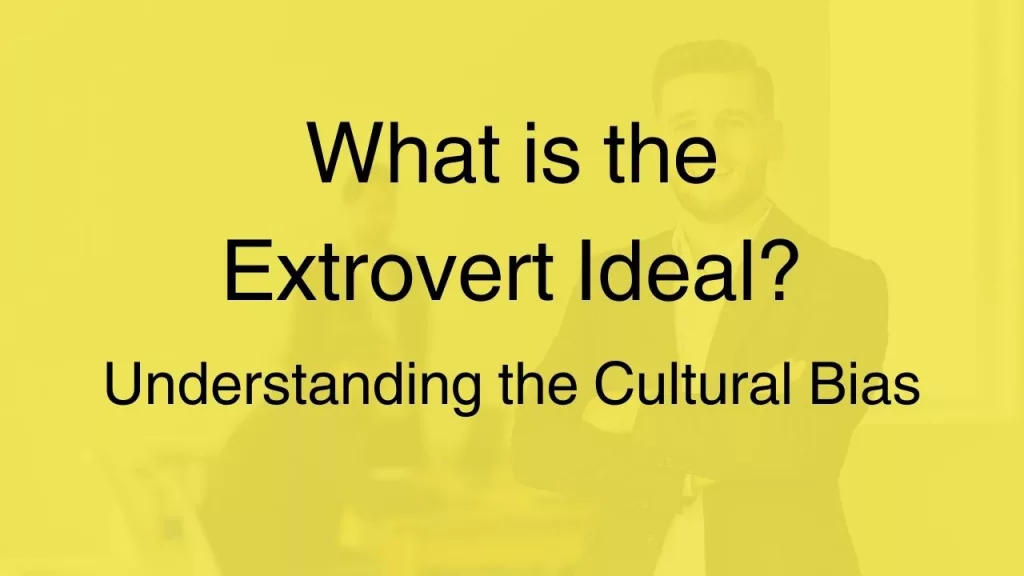The concept of the Extrovert Ideal, popularised by Susan Cain in her book Quiet: The Power of Introverts in a World That Can’t Stop Talking, is the idea that the ideal self should be ‘gregarious, alpha, and comfortable in the spotlight’ (extroverted). This is as opposed to being reserved, solitary and reflective (introverted).
The Extrovert Ideal has significantly influenced how we live, work and learn. The ripple effects of this ideal can be seen in workplace design (open offices), educational practices (grouped learning), and societal biases (forming friendships).
However, the tide is slowly turning. An increasing number of voices are challenging the flawed nature of this ideal, advocating for a more nuanced understanding of personality traits.
What is the difference between introversion and extroversion?
The core distinction between introversion and extroversion lies in where individuals derive and expend energy.
Introversion: Introverts gain energy from quiet environments or in small social settings. They expend energy in large groups and noisy environments.
Extroversion: Extroverts gain energy from social interactions and vibrant atmospheres but often feel depleted when alone.
Many characteristics often fall into each category. You can read more about this in my article: Introversion and Extroversion: Definitions, Origins and Examples.
Introverts and the Extrovert Ideal:
Many introverts learn to adopt an extroverted facade when necessary, such as during phone calls, social gatherings, or team meetings. This adaptability, often described as “faking it until you make it,” reflects the societal pressure to conform to extroverted norms. However, not everyone can seamlessly adopt this facade; and nor should they need to.
Why is faking it an issue?
- It’s exhausting,
- It’s impractical,
- It’s difficult,
- It’s unnecessary.
Your personality type is not something you can change. It’s your nature. Putting on a facade is a less-than-ideal circumstance for anyone in the professional environment.
Personal Reflection:
As an unabashed introvert, the struggle to conform to extroverted expectations is familiar. And the attempts to act against my nature can, and have, led to a sense of unworthiness and a feeling that something is amiss. It’s crucial to recognise that everyone has unique strengths, and introversion is not a flaw to be hidden; it is a trait to be embraced.
How can you embrace your introversion?
Contrary to popular belief, there is no one-size-fits-all ideal personality. Introverts, ambiverts, and extroverts each bring valuable qualities to different situations. Appreciating the diversity of personality types contributes to a fuller and more harmonious society.
To embrace your introversion, try the following steps:
- Acceptance: Acknowledge and embrace your introverted nature, and appreciate all the qualities that come with it, such as valuing quiet moments, thoughtful decision-making, and deep connections.
- Explore New Approaches: Experiment with alternative working styles that cater to your introverted tendencies. This can include remote work, quiet spaces or using headphones to block out the noise of bustling environments.
- Educate Yourself: Invest time in understanding your personality and explore resources that provide insights into how they influence decision-making, relationships, and overall attitude. The Myers-Briggs personality test is a great place to start.
How can we change the Extrovert Ideal?
Addressing and changing the cultural bias towards the extrovert personality type requires a collective effort. But it can be done. Here are some actionable steps we can take:
Raise Awareness: Encourage discussions and raise awareness about the diversity of personality types.
Educational Change: Advocate for educational reforms that accommodate different learning and communication styles, such as allowing for independent studying as well as group learning.
Workplace Inclusivity: Implement flexible work arrangements that cater to both introverted and extroverted employees, understanding that certain tasks may require different styles and settings.
Leadership Representation: Promote diverse leadership styles by celebrating introverted leaders; challenging the idea that extroversion is a prerequisite for leadership.
By collectively taking these steps, we can challenge the extrovert ideal and create a culture that values and celebrates the diversity of personalities.
Final thoughts:
The Extrovert Ideal has left an indelible mark on our culture. It affects our workplaces, education, and social perceptions.
It is time for us to acknowledge and celebrate the beauty of introversion; seeing it as equal to, not less than, extroverted and ambiverted personalities.
Was there anything I missed from this article?
What are your thoughts on the Extrovert Ideal?
Let me know in the comments.



